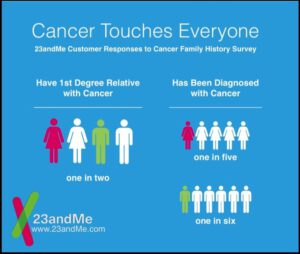
A new study by researchers at Boston’s Brigham and Women’s Hospital draws attention to the value of online resources to document family medical history.
23andMe customers can record their family medication information in several ways, including through our Cancer Family History survey – men’s version and women’s version.
Having a simple record of the conditions your siblings, parents, aunts, uncles and grandparents have faced can help both you and your doctor know what to watch out for to keep you healthy. But often people don’t know or have failed to keep track of that valuable information, making it harder for doctors to assess risks for things like cancer or other chronic diseases.
Scientists at 23andMe have shown how using family history information together with genetic testing can offer even better risk prediction for disease.
The new study published in the Journal of General Internal Medicine found that offering a simple online tool to track that history can help. About 10,000 patients were given an opportunity to fill out their family health histories and lifestyle information online while they waited for their physician visit. When they completed the questionnaire, patients were given a report that summarized their risks for cancer, heart disease, diabetes and stroke. The physician could also choose to transfer the submitted information into the patients’ electronic medical records. About 6,000 other patients in the study simply saw their physician as usual.
The study found that the online tool offered patients a chance to document important family medical history and helped doctors document histories of disease that otherwise would have been missed.
About 1,000 patients ended up filling out the tool, or 10 percent of those who were given the opportunity. Overall, two percent of those who had a chance to fill out the online tool had their family history information incorporated into their medical record within 30 days compared to 0.6 percent of patients that were not given the tool. Of those who filled out the tool, 10 percent had family history information incorporated into their medical record compared to 0.8 percent of patients that would have been likely to fill out the tool had they been given the chance. This may indicate that among patients motivated to provide their family history information, the tool increases the probability that the information is captured in their medical record.
While the study’s findings are very preliminary, it does suggest the value of online tools for better documenting family medical history information. Still, only 10 percent of those given the chance actually filled out the online tool, citing lack of time as the main reason. This suggests that providing access to the online tool well before the appointment (rather than in the waiting room) would increase uptake.
In a press release concerning the study, Baer said “This type of risk assessment tool may be useful for collecting information on family history and lifestyle factors and may also help increase communication between physicians and patients about their risk.”